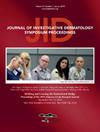A Potential Role for IL-4 and IL-13 in an Alopecia Areata–Like Phenotype: A Clinical Perspective
Q2 Medicine
Journal of Investigative Dermatology Symposium Proceedings
Pub Date : 2020-11-01
DOI:10.1016/j.jisp.2020.04.008
引用次数: 3
Abstract
Although alopecia areata (AA) has been traditionally classified as a strictly T helper type 1–mediated process, the T helper type 2 (Th2) pathway may contribute to an AA-like phenotype in some individuals. Herein, we describe three clinical cases that support the potential role of Th2 activity through the upregulation of IL-4 and IL-13 in an AA-like phenotype.
IL-4和IL-13在斑秃样表型中的潜在作用:临床观点
虽然斑秃(AA)传统上被严格归类为辅助性T型1介导的过程,但辅助性T型2 (Th2)途径可能在某些个体中导致AA样表型。在此,我们描述了三个临床病例,这些病例支持Th2活性通过上调IL-4和IL-13在aa样表型中的潜在作用。
本文章由计算机程序翻译,如有差异,请以英文原文为准。
求助全文
约1分钟内获得全文
求助全文
来源期刊
自引率
0.00%
发文量
0
期刊介绍:
Journal of Investigative Dermatology Symposium Proceedings (JIDSP) publishes peer-reviewed, invited papers relevant to all aspects of cutaneous biology and skin disease. Papers in the JIDSP are often initially presented at a scientific meeting. Potential topics include biochemistry, biophysics, carcinogenesis, cellular growth and regulation, clinical research, development, epidemiology and other population-based research, extracellular matrix, genetics, immunology, melanocyte biology, microbiology, molecular and cell biology, pathology, pharmacology and percutaneous absorption, photobiology, physiology, and skin structure.

 求助内容:
求助内容: 应助结果提醒方式:
应助结果提醒方式:


